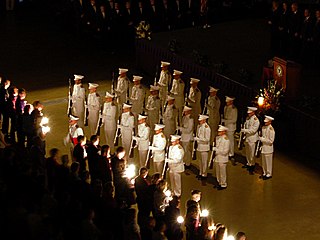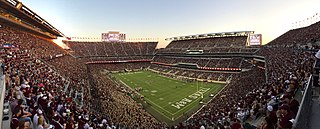
Hex Rally (sometimes Texas Hex) was a pep rally at The University of Texas at Austin that occurred in the week before the annual football game between the Texas Longhorns and their in-state rivals, the Texas A&M Aggies. [1]

Hex Rally (sometimes Texas Hex) was a pep rally at The University of Texas at Austin that occurred in the week before the annual football game between the Texas Longhorns and their in-state rivals, the Texas A&M Aggies. [1]
The Hex Rally traces its origins to 1941. Having lost the previous seven away games at Texas A&M, a group of worried UT students sought the advice of a local fortune teller, Mozzelle "Madame Augusta" Hipple. [2]
Hipple told the students to burn red candles the week before the game against A&M. The red symbolized challenge and opposition. In response, store owners, dorm residents, and other UT supporters around Austin burned red candles ceaselessly. That Thanksgiving, the Texas Longhorns snapped A&M's home winning streak with a 23–0 win. [3] [4]
The rally has been held annually, except in 2002 after the death of Texas A&M football player Brandon Fails, and 1999 when the rally's tone was altered in response to the tragedy of the Aggie bonfire collapse; organizers extended an invitation to all Aggies and their friends to the event, which was dubbed a "Unity Gathering." Instead of red candles, participants lit white candles in memory of the fallen Aggies. [5]
After UT's last game against Texas A&M in 2011, attendance quickly declined in following years until UT's athletic department finally discontinued participation in the event. The Texas Fight Rally, held the week before UT's annual game with the Oklahoma Sooners, remains as UT's primary annual football pep rally. [4]

The Texas Exes Student Chapter, sponsored by the Texas Exes alumni organization, organized the event. The Longhorn Band, cheerleading squad, Smokey the Cannon, the World's Largest Texas Flag, and football team all appeared at the event, where red candles were burned. [3]
As part of their rituals, UT held a bonfire similar in structure to the Aggie Bonfire. However, there was not sufficient lumber to build one as large, and student interest was lacking. UT Bonfire eventually died out in the mid-1980s. The physics department at the university decided to build an iron candle-like torch as a replacement, which was lit each year at the rally. [3]
The 2008 rally, held November 24, 2008, featured Longhorn football head coach Mack Brown, strength and conditioning coach, Jeff "Mad Dog" Madden, and the Longhorn Football Team. [6]

The Aggie Yell Leaders are a group of Texas A&M University students that lead Aggie fans in a series of "yells" during athletic events or other school events. The Yell Leaders are composed of five students who are elected annually by popular vote of the student body.
Midnight Yell Practice, known locally as Midnight Yell or Yell Practice, is a tradition at Texas A&M University. Midnight Yell is similar to a pep rally. On the night before each home football game, Midnight Yell takes place in Kyle Field at midnight; two nights before each away game, a Yell Practice is held near the Quadrangle on the south side of campus. At midnight on the night before an away game Midnight Yell is held in or near the opponent's city.

The Aggie Bonfire was a long-standing annual tradition at Texas A&M University as part of the college rivalry with the University of Texas at Austin. For 90 years, Texas A&M students—known as Aggies—built a bonfire on campus each autumn, known to the Aggie community simply as "Bonfire". The event symbolized Aggie students' "burning desire to beat the hell outta t.u.", a derogatory nickname for the University of Texas.

Aggie Muster is a tradition at Texas A&M University which celebrates the camaraderie of the university while remembering the lives of alumni who have died, specifically those in the past year. Muster officially began on April 21, 1903, as a day for remembrance of fellow Aggies. Muster ceremonies today take place in approximately 320 locations globally. The largest muster ceremony occurs in Reed Arena, on the Texas A&M campus. The "Roll Call for the Absent" commemorates Aggies, alumni and current students, who died that year. Alumni, family, and friends light candles and as they answer “here” when the name of their loved one is “called”. Campus muster also serves as a 50th-year class reunion for the corresponding graduating class. Some non-campus muster ceremonies do not include the pageantry of the campus ceremony, and might consist simply of a barbecue.
"Texas Fight" is the official fight song of the University of Texas at Austin and was written by Colonel Walter S. Hunnicutt in collaboration with James E. King, then director of the Marlin High School Band.

Kyle Field is the American football stadium located on the campus of Texas A&M University in College Station, Texas, United States. It has been the home to the Texas A&M Aggies football team in rudimentary form since 1904, and as a permanent concrete stadium since 1927. The seating capacity of 102,733 in 2021 makes it the largest in the Southeastern Conference and the fourth-largest stadium in the NCAA, the fourth-largest stadium in the United States, and the sixth-largest non-racing stadium in the world and the largest in Texas.

The Texas Longhorns are the athletic teams representing the University of Texas at Austin. The teams are sometimes referred to as the Horns and take their name from Longhorn cattle that were an important part of the development of Texas, and are now the official "large animal" of the U.S. state of Texas. Generally, both the men's and women's teams are referred to as the Longhorns, and the mascot is a Texas Longhorn steer named Bevo. The Longhorns have consistently been ranked as the biggest brand in collegiate athletics, in both department size and breadth of appeal.

The traditions of Texas A&M University are a key aspect of the culture of Texas A&M University. Some of the school traditions date to the 1890s, shortly after the opening of the school, while others have been introduced more recently. These traditions encourage current students and alumni (Aggies) to cultivate the Aggie Spirit, a sense of loyalty and respect for the school, and dictate many aspects of student life, including how to greet others, how to act at an A&M sporting event, and what words a student may use in conversation. The most visible tradition among senior class students and alumni is the wearing of the Aggie Ring, whose design has been relatively unchanged since its introduction in 1894. Not all Aggie traditions are recognized by the university, and some, like Bonfire, have been discontinued for safety reasons. Texas Monthly states that the students' respect for school traditions and values is the university's greatest strength.
The Spirit of Aggieland is the alma mater of the Texas A&M University. It was originally written as a poem by Marvin H. Mimms while he was a student at Texas A&M. Richard J. Dunn, the director of the Fightin' Texas Aggie Band at the time, composed the music. Students, faculty, and former students of the A&M sing the song at Aggie sporting events, Muster, and other events.

The 2005 Texas Longhorns football team represented the University of Texas at Austin during the 2005 NCAA Division I-A football season, winning the Big 12 Conference championship and the national championship. The team was coached by Mack Brown, led on offense by quarterback Vince Young, and played its home games at Darrell K Royal–Texas Memorial Stadium.

The 2006 Texas Longhorns football team represented the University of Texas at Austin in the 2006 NCAA Division I FBS football season. The team's head football coach was Mack Brown. The Longhorns played their home games in Darrell K Royal–Texas Memorial Stadium (DKR), which during 2006 was undergoing some renovations to improve older sections as well as to add extra seating capacity.

Jeff "Mad Dog" Madden was the strength and conditioning coach for the college football team of the University of Texas, the Texas Longhorns. He coached the team during the 2005 National Championships.

The Texas Longhorns football program is the intercollegiate team representing the University of Texas at Austin in the sport of American football. The Longhorns compete in the NCAA Division I Football Bowl Subdivision as a member of the Big 12 Conference. Their home games are played at Darrell K Royal–Texas Memorial Stadium in Austin, Texas.

The Texas A&M Aggies football program represents Texas A&M University in the sport of American football. The Aggies compete in the Football Bowl Subdivision (FBS) of the National Collegiate Athletic Association (NCAA) and the Western Division of the Southeastern Conference (SEC). Texas A&M football claims three national titles and 18 conference titles. The team plays all home games at Kyle Field, a 102,733-person capacity outdoor stadium on the university campus. Jimbo Fisher is the team's head coach.

The 2006 Texas A&M Aggies football team completed the season with a 9–4 record. The Aggies had a regular season Big 12 record of 5–3.
Many terms are unique to, or hold a special meaning connected with, Texas A&M University in College Station, Texas. The university, often called A&M or TAMU, is a public research university and is the flagship institution of the Texas A&M University System. It opened in 1876 as the Agricultural and Mechanical College of Texas, the first public institution of higher education in that state. In 1963, the Texas Legislature renamed the school to Texas A&M University to reflect the institution's expanded roles and academic offerings. The letters "A&M" no longer have any explicit meaning but are retained as a link to the university's past.
William Mack Brown is the former head coach of the University of Texas Longhorn football team. During his tenure, the Texas Longhorns football team under Mack Brown had a winning record in 15 of 16 seasons.
There are a multitude of rituals associated with collegiate sporting events across the United States. Varying by sport, demographics, and location, sporting rituals often become essential to the preparation, organization, and game-day experience. In fact, many would argue that rituals are the experience.

The Texas–Texas A&M football rivalry is an American college football rivalry between the Texas Longhorns and the Texas A&M Aggies. The rivalry was played every year between 1915 and 2011, until A&M left the Big 12 Conference to join the Southeastern Conference during the 2010–12 Southeastern Conference realignment as a part of the wider 2010–2014 NCAA conference realignment. Texas currently leads the series 76–37–5.

At approximately 2:42 a.m. on November 18, 1999, the annual Aggie Bonfire at Texas A&M University collapsed during its construction, killing 12 people and injuring 27.